Surfing Dogs: How to Teach Dogs to Surf
By Grant Piper
Updated on
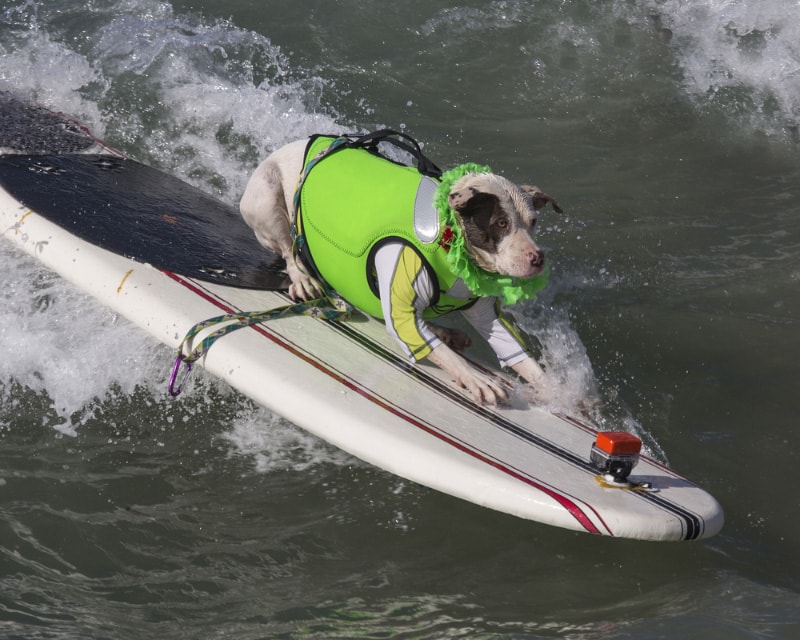
Click to Skip Ahead
The internet is filled with adorable pictures and awesome videos of dogs surfing. There are French Bulldogs riding calmly on a board wearing sunglasses. There are Golden Retrievers that are riding huge waves all on their own. Seeing these videos has made more than one person want to teach their own dog to surf. But where to start? Teaching a dog to surf is not easy. It takes a long time, and it requires consistent training over multiple sessions. However, it can be done. Most dogs that are receptive to training and like the water should be able to learn how to surf.
Here is how you can teach your dog how to surf in 10 easy steps, plus tips, tricks, and important things to remember.
Preparation
Before starting to teach your dog how to surf, there are some things that you need to acquire and understand. First, not every dog will be able to learn to surf. Some dogs simply hate the water. Other dogs will never feel comfortable on or around a surfboard. If this is the case, you might have to give up. In addition to the potential for failure, there are some things you will need to gather together and some important things that you need to know and understand before trying to stick your dog on a surfboard in the ocean.
| What You Will Need: |
|
| Difficulty: | Hard |
| Time: | 1–12+ months |
Things to Remember Before Starting
Sometimes, it is easy to forget that dogs are inherently different from people. Some people get an idea in their head without thinking about the little details. Dogs can surf, but they cannot surf in the same way that people can. Before you dive into the water with your dog, there are some things that you need to remember before starting.
- Dogs won’t appreciate surfing for the sake of surfing.
- Dogs cannot launch the surfboard on their own.
- Dogs cannot paddle or steer the surfboard on their own.
- Dogs cannot grip the surfboard as well as people can.
- Dogs do not wear wetsuits to keep themselves warm in the water for extended periods of time.
- Dogs cannot see as well as humans can, and they can become blinded by the water in certain conditions.
- Dogs can and will get bored or scared more easily than humans when out on the water.
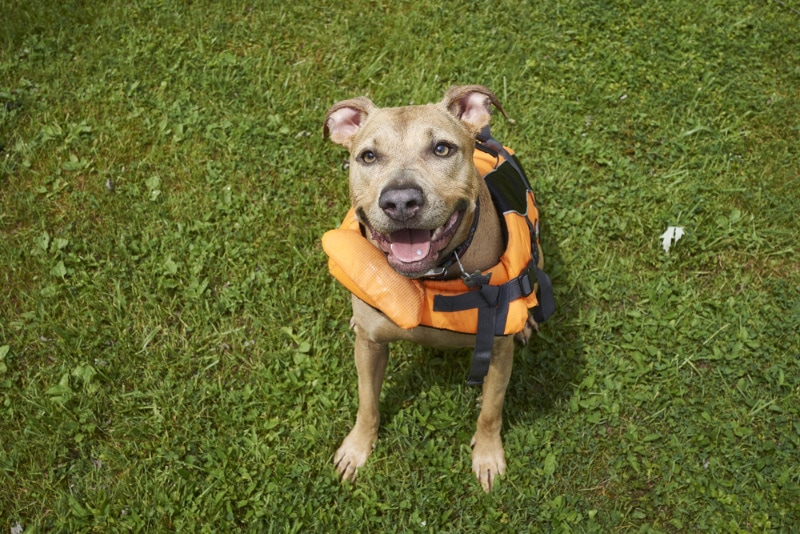
Overall Goals
Your overall goal is to get your dog to surf on a surfboard. However, that goal is built up of a number of smaller goals. Remembering these small goals will help keep you focused and on track with your training. Teaching a dog to surf can take weeks or months to master, so remembering the foundational goals can be very helpful throughout the process.
- Get your dog used to the surfboard.
- Get your dog to get on and off the surfboard safely.
- Get your dog to stand and stay on a surfboard.
- Get your dog to respond to voice commands when on the water, including stay and come.
These four goals are the foundations for a surfing dog. Without these four things, a dog will not be able to surf safely and effectively. Each step of the training process is focused on one of these goals.
The 10 Tips for Teaching Dogs to Surf
1. Introduce Your Dog to the Surfboard
The first thing you should do is introduce your dog to the surfboard. This should be done on dry ground and nowhere near the water. Lay the board on the ground and get your dog to come up to it. Let the dog explore the board. Let them circle it, sniff it, step on it, bark at it, or whatever else they want to do. You want your dog to become familiar with the surfboard. They need to recognize it, know what it is, get used to it over time.
No dog will truly hop onto a surfboard and become a natural overnight, no matter what stories you might hear. Dogs don’t know what surfboards are, to start off. You need to show them and teach them. It can take days, or even weeks in some cases, for dogs to get used to the surfboard. Teaching dogs to surf is not a quick process.
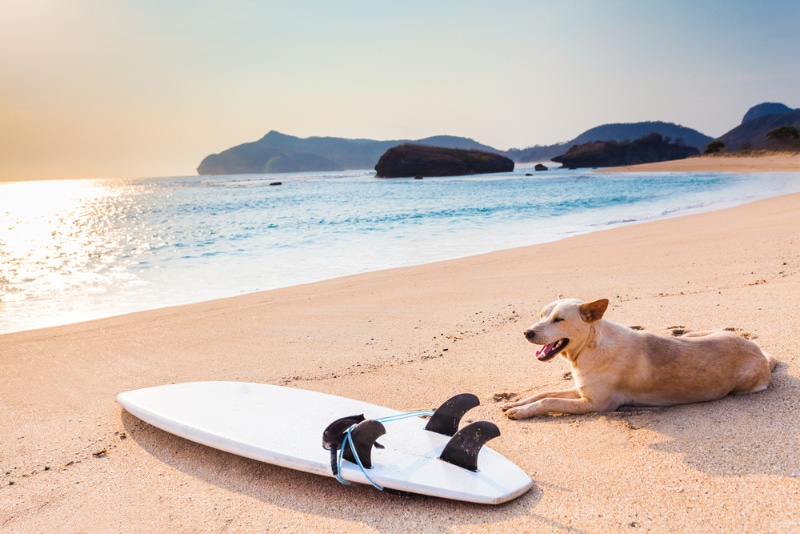
2. Get Your Dog to Get On and Off the Board
Once your dog is introduced to the surfboard and is used to seeing the surfboard, it is time to try getting them to get on and off the board. Again, this should be done on dry ground. You can do this in the backyard or near the pool. You want to get your dog to hop up onto the surfboard and stand on the board. You then want to get your dog to hop off of the surfboard. Ideally, you will be able to get your dog to get on and off the board on command. You can use commands like up or off. You can also use physical commands like patting the board or snapping your fingers to indicate on and off.
3. Get Your Dog to Stay On the Surfboard
Once your dog is comfortable getting on and off the board, it is time to start training them to stay on the board. This is a critical step in teaching a dog to surf. Many dogs’ natural instinct is going to be to get off the surfboard at the earliest convenience or to follow you wherever you go. You need to start getting your dog to get on the surfboard and stay standing or sitting on the board. Then, you need to start backing away and maintaining a reasonable distance from the surfboard because, in many cases, you will not be near the board when your dog is surfing on live water. Find commands that work for you, whether it is a hand or fist indicating stay or stop or a word such as “stay.”
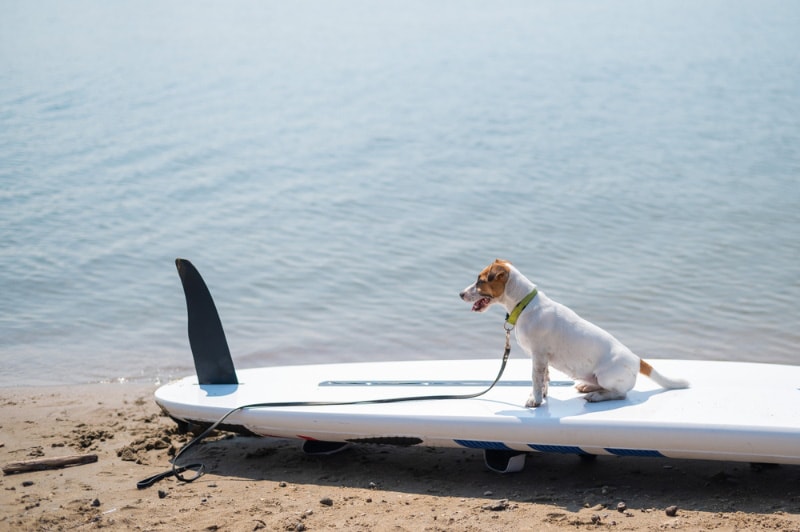
4. Reward Good Behavior Consistently
Throughout this process, you should be rewarding good behavior. Treats are an effective way to reward your dog during training. When your dog gets on the board, reward them. When a dog stays on the board, reward them. When a dog comes when called, reward them. This will start to build positive associations with the surfboard and with key skills like getting on and staying on the board.
5. Get in the Water and Start Over
Now, it is finally time to get in the water. The best place to practice with your dog in the beginning is in a pool or on a lake. You want to pick somewhere with calm waters where it is easy for you to stand and assist your dog. Once you’re in the water, it is time to repeat steps one through four.
You need to start getting your dog to be able to get on the board from the water. This can be tricky, but now your dog should be used to the board and should have positive associations with it. Get your dog on and off the board in the water. Let them do it on their own. Try not to pick them up or force them onto the board because that can lead to negative associations. After they can get on and off the board, you need to get them to stay on the board and remain on the board even if you are swimming away. When you release them from the board, they should jump off and swim to you.
Rock the board when they are in the pool to start getting them used to the movement of the surfboard. If they jump off, try to get them to stay when the board is rocking. Get behind the board and push it around by kicking your feet. You will need to do this in the ocean. Start pushing your dog on the board across the pool. Let go and let your dog glide on their own. You might even want to purposefully flip the board and dump your dog into the water and then reward them and make them feel safe. All of these things will be important in the future when you make it to the beach.
This will take time and practice to master, but these steps are important before you hit the actual ocean.
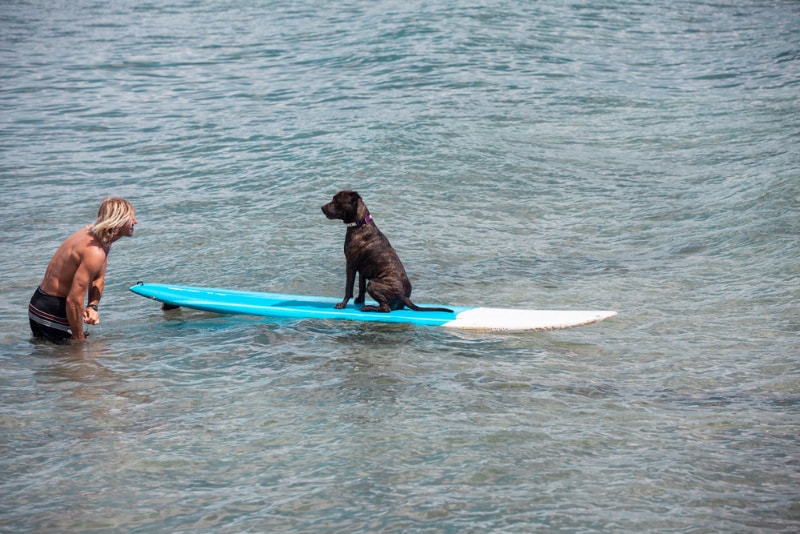
6. Use a Life Jacket
When you start doing live water training with the surfboard, it is a good time to put a life jacket on your dog. You should get your dog used to a life jacket so that they can remain safe while surfing in the ocean. Some dogs will hate their life jacket at first, and it can be distracting. Getting your dog used to a life jacket is critically important. Over time, your dog should get used to the life jacket, but you might need to work on the basics yet again with the life jacket on.
Remember, teaching a dog to surf is all about building skills and layering experiences. It takes a lot of repetition, but each step builds upon the last.
7. Hit the Ocean and Put It All Together
Before you go to the beach and try to put everything together, you should have mastered the previous six steps. Your dog should be comfortable around the surfboard and be able to get on and off the board while in the water. They should wear a life jacket, listen to your commands, and be able to swim effectively in their life jacket. If you have not mastered these steps, you should keep practicing before you go to the beach.
Now, it is time to start putting it all together. Put the surfboard in the water at the beach. Get your dog used to the movement of the waves and the differences between the water in a still pool and the moving water of the ocean. Make sure your dog is listening and responding well to being in the ocean. Make sure your dog is swimming well in their life jacket.
Now you can put your dog on the board and start practicing the surfing portion. It is time to hang ten!
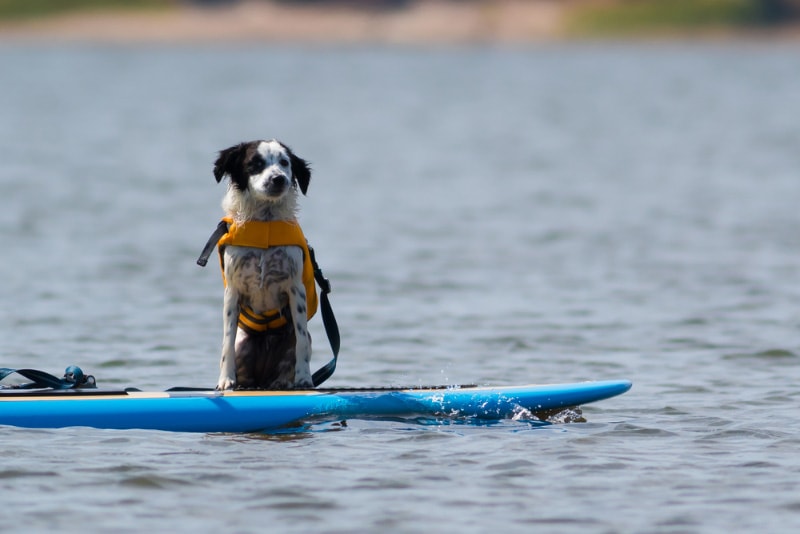
8. Learn to Launch
As mentioned at the top of the guide, dogs cannot launch, paddle, or steer the surfboard. They will need you to do that. The next step in the surfing process is getting your dog to actually ride a wave. To do this, you need to learn how to launch your dog on their adventure. Position the surfboard in a spot where you can push the board over a wave. Wait for some waves to start coming through. Make sure the board is pointing into the waves and is not being hit sideways. Once you get a good swell, push the board forward with your dog on it and let it go. If your dog is sturdy on the board and able to stay like you taught them, they should ride the wave toward the beach.
Your dog might freak out at this point and jump off the board. They also might try to leave the board and swim to you rather than stay on and ride the wave. These are things you might have to work on as time goes on.
9. Work On Positioning and Tweak Your Form
Once your dog starts getting used to riding some waves and getting over some swells, you can start working on positioning. You need to work on your positioning in the water so you can give your dog the best launches and best wave starts. You can also try to train your dog to stand on the nose of the board or lay down on the board when they are riding a wave.
Positioning is all about safety, effectiveness, and style. You can start adjusting your dog and yourself in order to hone in on the skill. This is where you begin to perfect your craft. This is also the step that is going to be a little different for everyone. Every dog is different. Some dogs will like being on certain parts of the board. Some dogs will be larger or smaller than other dogs. Positioning is where you tweak your dog and your board for the best possible outcome for you and your dog.

10. Practice, Practice, Practice
Lastly, it is time to practice, practice, practice. Practice makes perfect. And practice takes patience. Some dogs will take to surfing faster and better than others. Sometimes, it can take days of solid practice to get your dog to show progress. This can be a slow process. You and your dog will not get better until you practice consistently and tweak your form.
Surfing Tips to Consider
- Always use a life jacket with your dog.
- Don’t forget to bring food and water for your pup. Water is especially important.
- Don’t let your dog drink salt water.
- Don’t force your dog to do anything that they don’t want to do when they are in the water, as it can cause them to panic.
- Don’t let your dog stay in the water for too long, as they can get too hot, too cold, too tired, or dehydrated.
- Watch videos to get some visual cues on what to do in certain situations.
- Always keep an eye on your dog when they are in the water. Know where they are at all times. Don’t let them out of your sight.
Conclusion
With patience, practice, and dedication, you can teach your dog how to surf. It won’t necessarily be easy, but it will be fun. Teaching a dog to surf can be a great hobby, and it can help you bond with your dog. After enough time and practice, your dog could be riding waves at the beach, enjoying the sun and the surf. Safety is important at all times. So is patience and understanding. Dogs were not made to surf, and some dogs won’t want to surf. But if you pull it off, the results can be incredibly rewarding.
Featured Image Credit: Chuck Aghoian, Shutterstock














